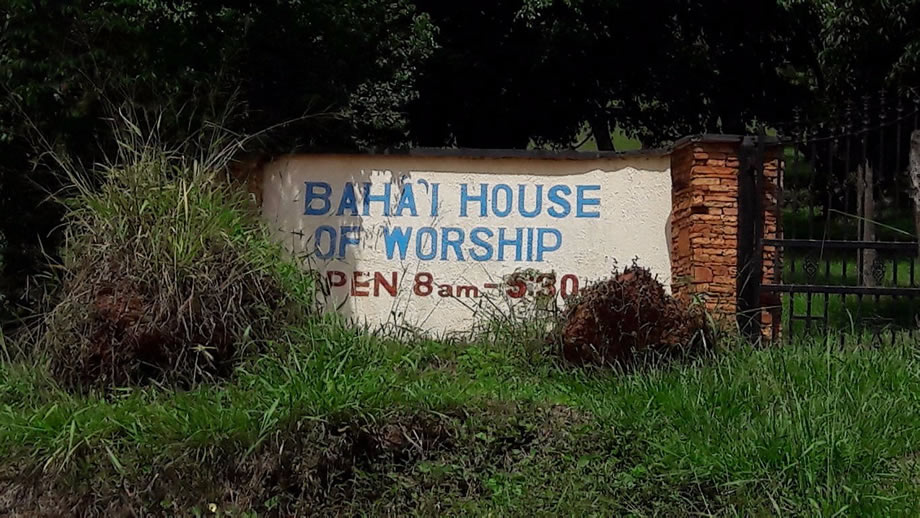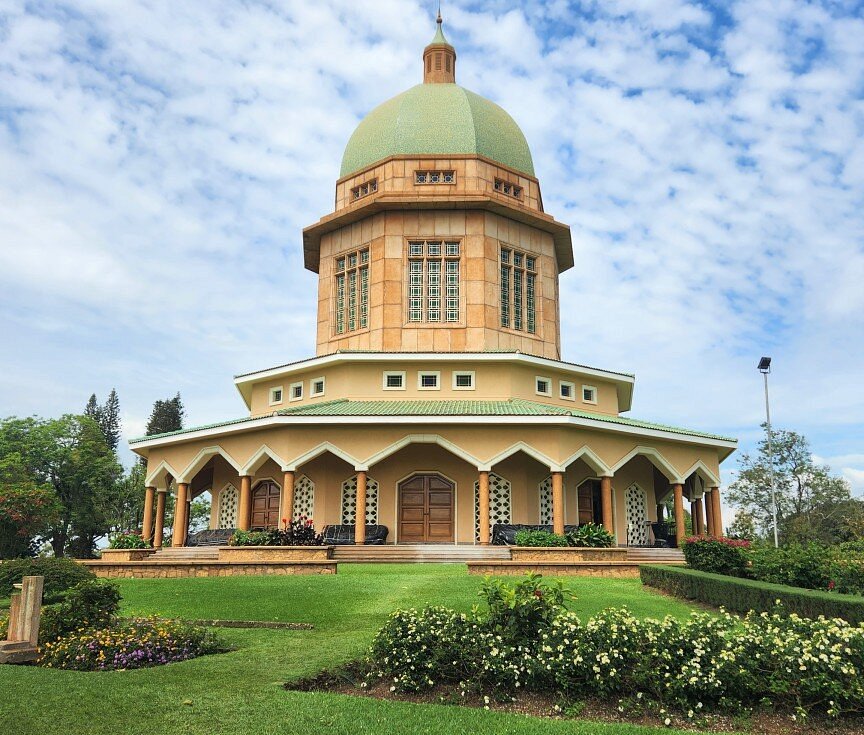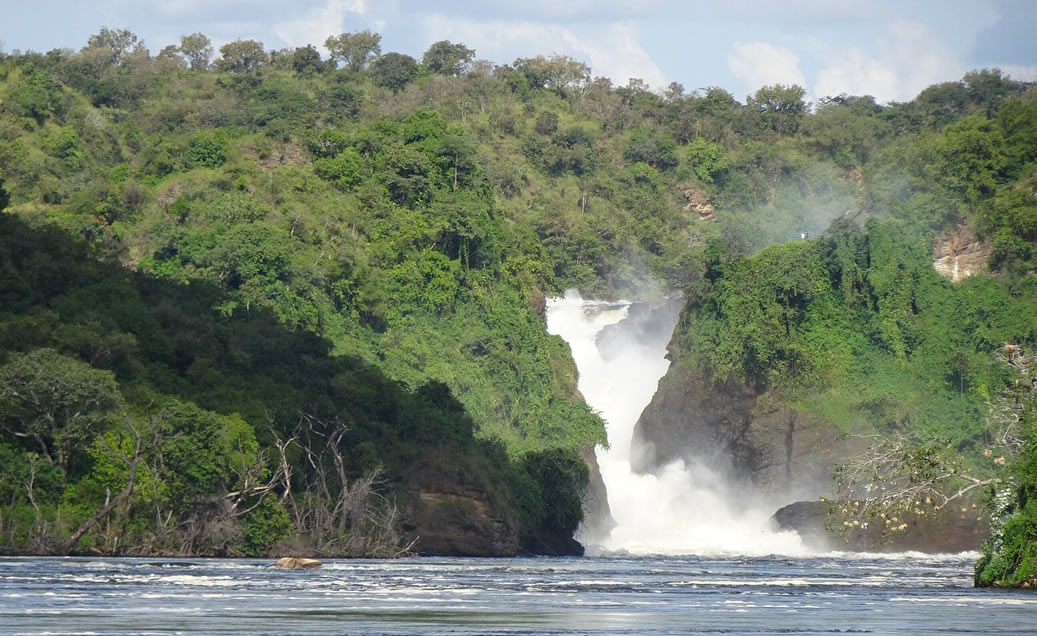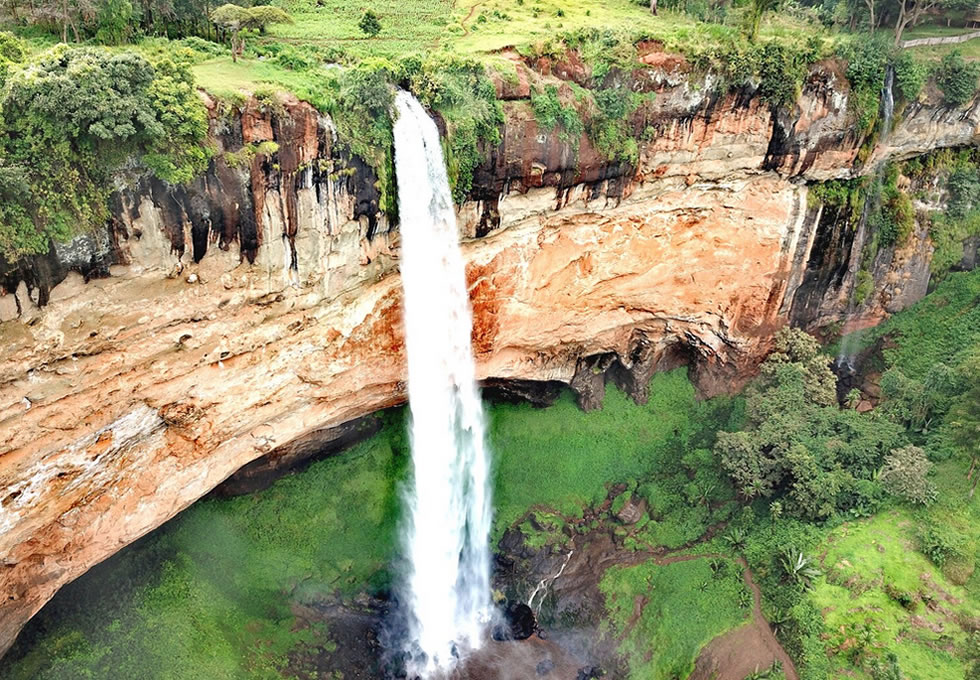Bahai temple is the dawning place of the praise of God. From miles away, a green pasture and majestic pillars can be seen on the hill, iconic against the western horizon of Kampala. It is the mother, Temple of the Bahai faith in Africa, out of only seven in the World. And just like the faith it represents, the Bahai temple is no ordinary house of worship.
There are eight Bahia Temples in the world with the Mother Temple of Africa located in Uganda. During the rule of President Idi Amin, the Bahai Faith was banned and the Bahai Hand of the Cause Enoch Olinga, and his family were murdered.
 Bahai Temple sitting on 52 acres of land, the temple is a unique architectural masterpiece. It was designed by Charles Mason Remey, who was a prominent and controversial American Bahai and its foundation stone was laid in January 1958. A few meters from the Temple is the dormitory of the mausoleums which are themselves marvels of design.
Bahai Temple sitting on 52 acres of land, the temple is a unique architectural masterpiece. It was designed by Charles Mason Remey, who was a prominent and controversial American Bahai and its foundation stone was laid in January 1958. A few meters from the Temple is the dormitory of the mausoleums which are themselves marvels of design.
Thousands of tourists from all corners of the world visit the Bahai Temple every year to gaze at and admire the beauty of this building with its breathtaking view.
Built between 1958 and 1961 on Kikaaya Hill, three miles North of Kampala the building is 130ft. Its dome is 44ft in diameter. It is a nine-sided structure that represents oneness and unity.
 The temple has a sitting capacity of over 600 people. The green dome is decorated with tiny mosaic tiles that were imported from Italy, while the roof tiles were imported from Belgium. The walls were built with locally sourced pre-cast stones while reinforcing steel, window frames, and fittings were imported from the UK.
The temple has a sitting capacity of over 600 people. The green dome is decorated with tiny mosaic tiles that were imported from Italy, while the roof tiles were imported from Belgium. The walls were built with locally sourced pre-cast stones while reinforcing steel, window frames, and fittings were imported from the UK.
The colored glass came from Germany. Inside the temple are woolen carpets imported from Turkey and the interior will leave anyone in awe.
Community activities
The Bahai community of Uganda has sponsored a number of social and economic development programmes in Uganda aimed at promoting the welfare of the local communities.
The picturesque site.
The ambiance here in serene. The sprawling gardens sitting on several acres are covered with beautiful flowers and trees. They are clean and well-mowed, just a perfect site for a family.
Young people from the neighborhood sometimes come here to revise their books in a quite environment. Some of the trees in the gardens include Musizi, Mvule, Mahogany, Pine, and Eucalyptus.
According to George Olinga, the Director of external affairs of the Bahai faith in Uganda, most of the trees were planted by the Bahai faithful in the 1950s. Also in the gardens are the Tombs where the Bahai faithful who die in Kampala are buried. Olinga says the law of the faith states that one should be buried within an hour after death.
One dies in Kampala and transporting the corpse to their ancestral home would take more than an hour, we bury them here, Olinga says. The graves come in all shapes and designs, the most notable being of Enoch Olinga, which is shaped like the map of Africa.
Massive Tourist Attraction.
On the day we visited Bahai Temple. The massive flow of tourists, most of the foreigners, left us speechless. For two hours we spent there, over 40 tourists visited the place, many coming from as far as India, Slovakia, the USA, Sweden, and the UK. John, one of the Guides at the temple, says they receive over 80 tourists a day. Unfortunately, although the administration employs several Guides and laborers to maintain the place, tourists do not pay any coin to tour the place, hence missing out on some good money.
Not even the locals have been keen to tap into the opportunities as there are no artifacts or souvenirs sold near or around the Place. Olinga said the reason they do not charge any coin is that the Bahai house of worship should be free to all people at all times regardless of race, background, and religion.
History of The Baha’i Faith in Uganda
The Baha’i Faith was introduced in Uganda in August 1951 by the arrival of Baha’is from Iran and the United Kingdom, which included Mr. Musa and Mrs. Samiyye Banani, Mr. Phillip Hainsworth, Mr.Ali, and Mrs.Violette Nakhjavani and their daughter, Bahiyyih Nakhjavani. The first Local Spiritual Assembly, which is the local administrative council in the Baha’i Faith was formed in April 1952 and consisted of Mr. and Mrs. Banani, Mr.Ali and Mrs. Violette Nakhjavani, Mr. Phillip Hainsworth, Mr.Crispian Kajubbi who was the first Ugandan Baha’i, Mr.Fred Bigarwa, Mr.Peter Musoke, and Mr. Enoch Olinga.By October 1952, there were well over 100 Baha’is in Uganda from 15 different tribes and from Protestant, Catholic, and other backgrounds.
By May 1954 the number had risen to well over 670 for the whole of Uganda, comprising of more than 20 different tribes. In 1953, pioneers from Uganda went on to spread the Baha’i Faith to other parts of Central Africa including the British Cameroons (Mr. Enoch Olinga), Belgian Congo (Current DRC) (Mr.Sam Mungono), and Congo Brazzaville (Mr.Max Kanyerezi). The Intercontinental Conference for Africa was held in 1958 This conference also marked the laying of the foundation stone for the Mother Temple of Africa on 26th January 1958 by Ruhiyyih Khanum and Musa Banani.
How Bahai Faith Began
The Baha’i Faith began in Persia. On May 23, 1844, a young man known as the Bab proclaimed Himself to be a Messenger of God. He told of one greater than Himself, a great world Teacher and revealer of the word of God who would come to bring in an age of peace for mankind. After five years of persecution, the Bab was martyred on July 9, 1850, in Tabriz, Persia. He was 31 years old. In 1863, Baha’u’llah was declared to be the one foretold by the Bab and all the previous Prophets.
Like every Messenger of God, Baha’u’llah was bitterly opposed and persecuted. Like Abraham, He was exiled, like Moses, He was stoned, like Jesus, He was scourged. After nearly forty years of suffering and imprisonment, Baha’u’llah passed away in exile on May 29, 1892, at the age of seventy-five in the prison city of Akka. It was Akka which Isaiah had foretold would be a place of refuge for God’s creatures. Hosea too spoke of this valley as a ‘door of hope’ for humanity. By Kabagambe Gerald









